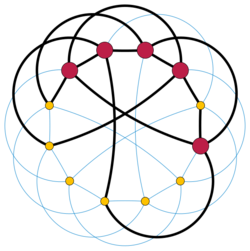Kelmans–Seymour conjecture
In graph theory, the Kelmans–Seymour conjecture states that every 5-vertex-connected graph that is not planar contains a subdivision of the 5-vertex complete graph K5. It is named for Paul Seymour and Alexander Kelmans, who independently described the conjecture; Seymour in 1977 and Kelmans in 1979.[1][2] A proof was announced in 2016, and published in four papers in 2020.
Formulation
A graph is 5-vertex-connected when there are no five vertices that removed leave a disconnected graph. The complete graph is a graph with an edge between every five vertices, and a subdivision of a complete graph modifies this by replacing some of its edges by longer paths. So a graph G contains a subdivision of K5 if it is possible to pick out five vertices of G, and a set of ten paths connecting these five vertices in pairs without any of the paths sharing vertices or edges with each other.
In any drawing of the graph on the Euclidean plane, at least two of the ten paths must cross each other, so a graph G that contains a K5 subdivision cannot be a planar graph. In the other direction, by Kuratowski's theorem, a graph that is not planar necessarily contains a subdivision of either K5 or of the complete bipartite graph K3,3. The Kelmans–Seymour conjecture refines this theorem by providing a condition under which only one of these two subdivisions, the subdivision of K5, can be guaranteed to exist. It states that, if a non-planar graph is 5-vertex-connected, then it contains a subdivision of K5.
Related results
A related result, Wagner's theorem, states that every 4-vertex-connected nonplanar graph contains a copy of K5 as a graph minor. One way of restating this result is that, in these graphs, it is always possible to perform a sequence of edge contraction operations so that the resulting graph contains a K5 subdivision. The Kelmans–Seymour conjecture states that, with a higher order of connectivity, these contractions are not required.
An earlier conjecture of Gabriel Andrew Dirac (1964), proven in 2001 by Wolfgang Mader, states that every n-vertex graph with at least 3n − 5 edges contains a subdivision of K5. Because planar graphs have at most 3n − 6 edges, the graphs with at least 3n − 5 edges must be nonplanar. However, they need not be 5-connected, and 5-connected graphs can have as few as 2.5n edges.[3][4][5]
Claimed proof
In 2016, a proof of the Kelmans–Seymour conjecture was claimed by Xingxing Yu of the Georgia Institute of Technology and his Ph.D. students Dawei He and Yan Wang.[1] A sequence four papers proving this conjecture appeared in Journal of Combinatorial Theory, Series B.[6][7][8][9]
See also
References
- ↑ 1.0 1.1 Condie, Bill (May 30, 2016), "Maths mystery solved after 40 years", Cosmos, https://cosmosmagazine.com/mathematics/maths-mystery-solved-after-40-years.
- ↑ Note however that (Thomassen 1997) dates Seymour's formulation of the conjecture to 1984.
- ↑ "Homomorphism theorems for graphs", Mathematische Annalen 153: 69–80, 1964, doi:10.1007/BF01361708
- ↑ "Dirac's conjecture on [math]\displaystyle{ K_5 }[/math]-subdivisions", Discrete Mathematics 165/166: 607–608, 1997, doi:10.1016/S0012-365X(96)00206-3
- ↑ Mader, W. (1998), "[math]\displaystyle{ 3n-5 }[/math] edges do force a subdivision of [math]\displaystyle{ K_5 }[/math]", Combinatorica 18 (4): 569–595, doi:10.1007/s004930050041
- ↑ He, Dawei; Wang, Yan; Yu, Xingxing (2019-12-11). "The Kelmans-Seymour conjecture I: Special separations". Journal of Combinatorial Theory, Series B 144: 197–224. doi:10.1016/j.jctb.2019.11.008. ISSN 0095-8956. http://www.sciencedirect.com/science/article/pii/S0095895619301224.
- ↑ He, Dawei; Wang, Yan; Yu, Xingxing (2019-12-11). "The Kelmans-Seymour conjecture II: 2-Vertices in K4−". Journal of Combinatorial Theory, Series B 144: 225–264. doi:10.1016/j.jctb.2019.11.007. ISSN 0095-8956. http://www.sciencedirect.com/science/article/pii/S0095895619301212.
- ↑ He, Dawei; Wang, Yan; Yu, Xingxing (2019-12-09). "The Kelmans-Seymour conjecture III: 3-vertices in K4−". Journal of Combinatorial Theory, Series B 144: 265–308. doi:10.1016/j.jctb.2019.11.006. ISSN 0095-8956. http://www.sciencedirect.com/science/article/pii/S0095895619301200.
- ↑ He, Dawei; Wang, Yan; Yu, Xingxing (2019-12-19). "The Kelmans-Seymour conjecture IV: A proof". Journal of Combinatorial Theory, Series B 144: 309–358. doi:10.1016/j.jctb.2019.12.002. ISSN 0095-8956. http://www.sciencedirect.com/science/article/pii/S0095895619301248.
 |


